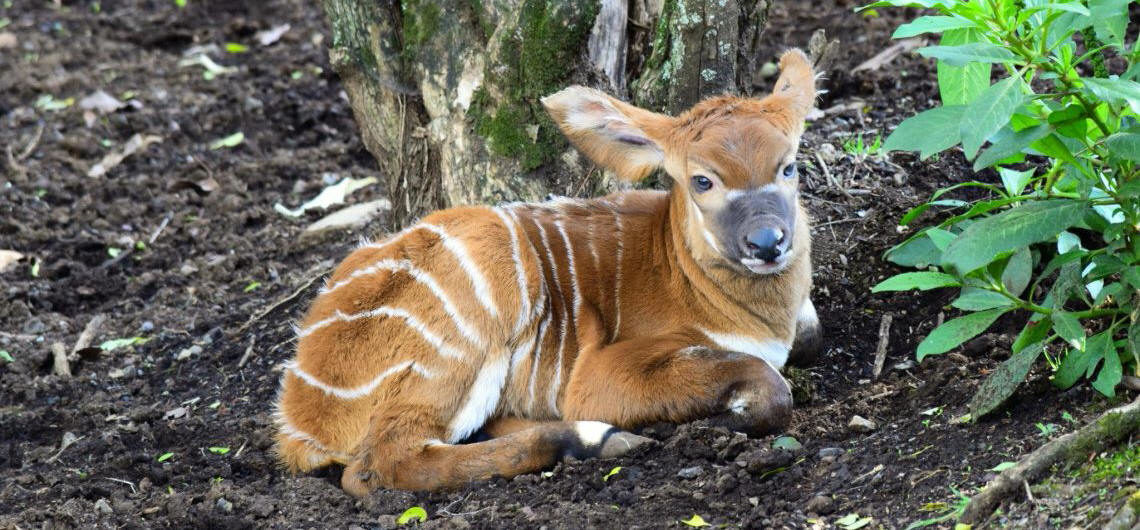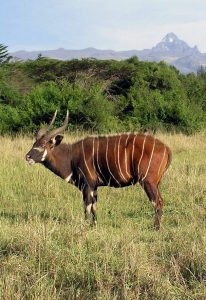The Mountain Bongo (Tragelaphus eurycerus isaaci) is an endangered tragelaphine antelope sub-species that is endemic to Kenya. Specifically found in four ranges: Aberdare ranges, Mount Kenya, Eburu and Mau Forests.
Interesting facts about the Mountain Bongo
- The Mountain Bongo is the largest, heaviest and most colorful African forest antelope.
- It has an auburn or chestnut coat with 10 to 15 vertical whitish-yellow stripes running down its sides.
- They are quite timid and are easily frightened. Therefore, they prefer to live in dense and tangled undergrowth. They are found in high altitude montane forests of about 2000-3000 meters.
- The large ears are believed to sharpen their hearing and the distinctive coloration may help the bongos identify one another in their dark forest habitats.
- They are both browsers and grazers, eating a variety of leaves, shoots and grasses. They sometimes feed on leaves by using their horns to twist and break the branches of trees and shrubs.
- The bongo can reach a speed of 69 kilometres per hour when it needs to escape from predators. It runs with horns positioned parallel to its back to avoid contact with nearby vines and lianas.
- The Bongo has a lifespan of 12 years in the wild and up to 22 years in captivity.
Critically Endangered
The Mountain Bongo is classified as a ‘Critically Endangered Species’ by the International Union for Conservation of Nature (IUCN). Kenya has less than 100 individuals left in the wild and 76 individuals under in situ breeding program.
The threat to the existence of the Mountain Bongo has been threefold:
- The Bongo’s habitat has declined in size due to human encroachment, destruction and other economic activities.
- The Bongo was most priced trophy for sport hunters for both its beautiful coat and for trade in zoos around the world during the colonial era. They have also been hunted for family protein supplementation and bush meat trade.
- Natural factors such as disease, predation, plant toxicity and intra-specific aggression have led to loss of large herds
National Recovery and Action Plan
In 2003, a bongo repatriation program from the USA was initiated to establish a sustainable, in situ managed bongo population at the Mount Kenya Wildlife Conservancy from which multiple wild-population recovery strategies could evolve. The principal objective of this project was to establish an in situ captive breeding program, in a natural setting, as the first phase of several conservation steps required to reintroduce mountain bongos to the wild.
The program saw the repatriation of 18 Mountain Bongo from the United States where they were held in zoos. It aims to grow the number of Mountain Bongos and avail them to the National Bongo Conservation Task Force (NBTF) under The Mountain Bongo Breeding Program Repatriation Project. Through the Mountain Bongo Breeding Program Repatriation Project, the Mount Kenya Wildlife Conservancy has steadily grown its Mountain Bongo population from 18 in 2004 to 76 individuals as at July 2019.
Following the success of the breeding program the second phase will see the creation of a Mountain Bongo Sanctuary within Mount Kenya Forest where the Bongo will have minimal interaction with humans with no nutritional supplementation. This will transition the Bongos and make the first generation born there totally wild and ready for release to the wild by 2024 in line with the National Recovery and Action Plan for the Mountain Bongo (2019-2023). This plan envisages viable, free-ranging & genetically representative populations of Mountain Bongo, thriving across intact historic mountain ecosystem ranges, cherished by the Kenyan & global community. The overall goal of the plan is to secure minimum population size for mountain bongo within their ranges in Kenya, to achieve a national population of 750 individuals over the next 50 years.
Source and more photos: Kenya Wildlife Service


